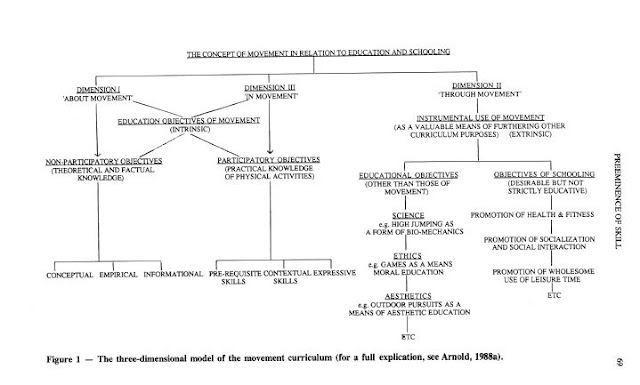Should PE get a 'divorce' from HPE?
In Australia, an Arnoldian (Arnold, 1979, 1985, 1988) perspective on PE has been presented as 'gold standard' and used to guide the form/domains of knowledge and substance/content of curriculum documents. While 'knowledge' is divided into the dimensions of education about, in and through movement, in an Arnoldian perspective movement skill attainment is 'preeminent'.
"It is the study and practice of
physical activity that renders physical education an indispensable subject in a
balanced educational programme" (Kirk, 1988, p. 80). Tinning, Macdonald,
Wright and Hickey (2001) concluded that learning in movement has been the traditional area of focus for Australian
physical education. Has too much emphasis shifted from teaching in PE for 'participatory objectives' to other objectives while the need for teaching for learning attainment of movement competence has never been more needed in Australia?
Arguably, the move to HPE as a learning area in the 1990s blurred the boundaries and
distinctiveness between the previously bounded subjects of Health and Physical Education and their skill, knowledge
and content bases. It is my experience that for many teaching HPE, the boundaries and
the relationship between the two subjects making up the learning area remain unclear in practice when advocacy for 'health promoting PE' arise. Teacher ability to teach for and subsequently expect movement skill attainment seems less obvious.
Evidence in Australia (and in most 'westernised' countries) of declining movement ability of children over the past 30 years provides the optics that school physical education that results in the level of movement competence that leads to the perceived and actual self efficacy underpinning the confidence to choose to be active is not there for many (maybe most) children and youth since the creation of HPE. In creating HPE, PE has been opened up to influence by agencies outside education that are interested in
it as a site for health and physical activity interventions to address the “obesity crises”. Whether or not the obesity discourse assists or hinders physical education in
Australia is a matter Gard (2006) considered. 'Sport' in PE has been positioned as an example of what is 'old school', wrong, and marginalising about PE by many critical HPE theorists, and the role that sport can play in shaping the
broader development of children and young people and their growth into
particular types of people is often ignored (Light & Georgakis, 2007). The Australian Government (2009) Independent Sport Report noted that "it was concerning to learn from experts
Australia-wide that the education system no longer reliably provides the platform upon which
much of the nation’s sporting activity is based. It no longer consistently carries out the vital role of
introducing children to physical activity and organised sport." It was further noted, "The delivery of physical education and organised sport should be reinstated as a key component
of the school curriculum across the country. Australian governments should make sport in schools
an ongoing priority and agree that physical education must be delivered by each school as if it
were a separate key learning area in the national curriculum".
If based on the evidence of FMS attainment research, and in Australia there seems to be more of this research than anywhere else (see here for a summary), it appears clear that a mature debate is needed as to whether PE needs to be divorced from HPE if it is to be able to be focussed on 'turning around' what is now inter-generational movement (in)capability.
Thanks for stopping by and reading this post. If you would like to connect with me on a project to do with teaching for effective learning in PE or any of the other ideas I have posted on, you can contact me by the email link available here





Comments
Post a Comment